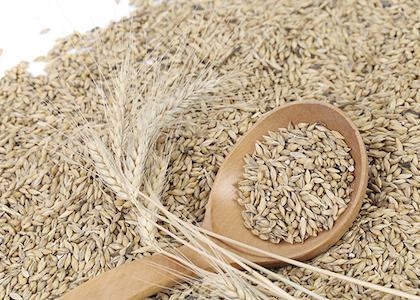
Get to Know Gluten (& 5 Healthy Swaps)
By Jody Paglia Tanzman, RD,LDN,CLC
What exactly is Gluten?
Gluten is a protein that gives structure, elasticity and mouth-feel to breads, pastas, muffins and cereals. It is also used as a flavoring additive, a thickener and a stabilizing agent and can be found in countless foods and beverages, vitamins, medications, cosmetics and dental hygiene products. Gluten is naturally found in wheat, rye, barley and triticale. Contrary to some beliefs, oats do not contain gluten. They do contain some proteins that are chemically similar to gluten, but research has shown that most people who are sensitive to gluten can consume them safely. However, some oats are grown close to fields with gluten-containing grains, and through wind, birds and machines in the processing plants (facilities often process several kinds of grains) they might contain traces of gluten.
Who is affected by Gluten?
About 1 in 133 people have celiac disease, an autoimmune disease in which their bodies cannot properly digest gluten. In those people, gluten causes inflammation in the small intestines, and damages the villi within it. This interferes with the absorption of nutrients (iron, calcium, and vitamins D and K, for example) and allows larger molecules to pass easily through the intestinal wall (aka “leaky gut”). Digestive symptoms such as constipation, diarrhea (often times diagnosed as irritable bowel syndrome) and bloating can occur as a result.
What does it mean to be Gluten Intolerant?
Not everyone experiences GI distress. There are countless symptoms linked to celiac disease, such as chronic fatigue, depression, irritability, bone and joint pain, indigestion and canker sores, to name a few. Many people test negative for celiac disease but still have symptoms similar to people who have celiac. Those people have a non-celiac gluten sensitivity or intolerance. Current research suggests that six times the amount of Americans with celiac disease have a gluten sensitivity. Following a strict gluten-free diet can help prevent or reverse many of gluten’s effects.
Being gluten-free doesn’t mean that you can never enjoy bread products again. There are some great gluten-free products on the market now. There are also some easy swaps that you can do at home.
How can I enjoy my favorite foods without Gluten?
Here are a few of the best swaps to make when you remove gluten from your diet.
1.) Breadcrumbs — Ground nuts are a great swap out for wheat-based breadcrumbs. Pulse raw nuts of your choice in a food processor, quick pulsing until you get the texture you prefer. I like mine a little on the coarse side, to give a little crunch like a panko breadcrumb would. Pecans, almonds and pistachios are particular favorites of mine. I use them as a breading for proteins, and as a replacement for breadcrumbs in stuffings. For maximum flavor, toast the nuts before using, or use dry roasted nuts.
2.) Wheat Flour — Instead of wheat flour for your baking, substitute gluten-free whole grains such as millet, quinoa, sorghum, brown rice, amaranth, buckwheat and teff. These grains are loaded with fiber and essential vitamins and minerals. Use bean flours, ground nuts and flax meal to boost fiber and protein and add color and interesting flavors. Remember that you should not swap out an equal ratio of wheat flour to gluten-free flour. It’s important to consider the taste and texture. You will also need to incorporate a starch or leavening agent to make the final product light.
As a thickener for soups, sauces, and fillings, arrowroot, cornstarch, rice flour and potato starch are all great substitutions for wheat flour. Each imparts a slightly different taste and look of the final product. To avoid lumps, mix the starch in a little cold water or other liquid first in order to dissolve it. Then add it to whatever hot liquid you are trying to thicken. These replacement thickeners should be simmered only briefly, not boiled, or they could lose their thickening strength. You can also puree cooked vegetables or grate starchy vegetables such as potatoes directly into soups and stews to thicken.
3.) Oats — Though oats can be gluten-free, many of the most popular brands are not (make sure to check the label of the product to be sure it is certified gluten-free). A great gluten-free swap out for your morning oatmeal is cooked quinoa. A high protein grain full of folate, zinc and fiber, quinoa also makes a lovely breakfast cereal. Use a 2:1 ratio of liquid to quinoa. I like to cook the quinoa in water for about 20 minutes, and then add coconut or nut milk to the thickened cereal. Add fruit, sweeteners and spices such as cinnamon and vanilla to taste, just as you would oatmeal. Another gluten-free grain that works well with this same ratio is iron-rich amaranth, as its tiny beads make quite a creamy porridge when cooked.
4.) Wheat-based Protein Powders — Wheat based powders are ubiquitous. Whey protein powders are also readily available, but despite being made from milk, some whey powders do contain glutamine, which is derived from wheat protein. And many whey protein powders are processed in facilities that also process wheat products. In addition, many people with gluten sensitivities are also sensitive to dairy and soy. Try 100% pea, rice or hemp powder instead, as these products are often more easily tolerated, have natural anti-inflammatory properties, are high in fiber and are naturally gluten free. Try mixing all three for a complete amino acid profile.
With these simple swaps in your arsenal, cooking gluten-free is easier than ever. Just remember that no matter which brands or types of products you choose, you should always check the label carefully.